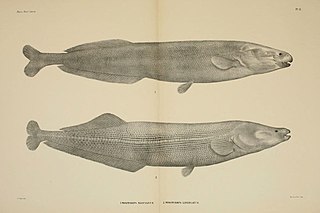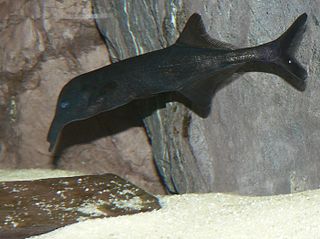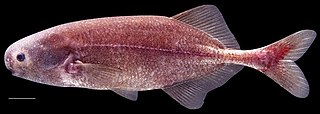
The family Mormyridae, sometimes called "elephantfish", are freshwater fish in the order Osteoglossiformes native to Africa. It is by far the largest family in the order with around 200 species. Members of the family can be popular, if challenging, aquarium species. These fish are also known for having large brain size and unusually high intelligence.

Labeo is a genus of carps in the family Cyprinidae. They are found in freshwater habitats in the tropics and subtropics of Africa and Asia.
Mastacembelus is a genus of many species of spiny eel fish from the family Mastacembelidae. They are native to Africa and Asia. Most are found in rivers and associated systems, but there are also species in other freshwater habitats and a particularly rich radiation is found in the Lake Tanganyika basin with 15 species. A few species can even occur in brackish water.

Synodontis is the largest genus of mochokid catfishes. It is the biggest genus within the 10 genera and 190 different species in the family Mochokidae. Synodontis has over 131 different species within the genus. Synodontis are also known as squeakers, due to their ability to make stridulatory sounds through their pectoral fin spines when handled or disturbed. Synodontis make a sound that sounds like squeaking by rubbing their spines together. They do this when they have been frightened or when they become angry. Synodontis may also squeak when they are taken out of the water. These catfish are small- to medium-sized fish with many species exhibiting attractive spotted markings. Some species are also known for naturally swimming belly-up, earning the name upside-down catfish. Some of these species are Synodontis contractus and Synodontis nigriventris. While some of these species are known to swim upside down, another species, Synodontis multipunctatus, is a brood parasitic cuckoo catfish.

Brycinus is a genus of ray-finned fish in the family Alestiidae. Like other "African characids", they were formerly included in the Characidae but are actually somewhat more distantly related Characiformes.

Chrysichthys is a genus of claroteid catfishes native to Africa. Two fossil species are known. Chrysichthys macrotis, Van Neer, 1994, is known from the Miocene-Pliocene of the Albertine Rift in Uganda and Chrysichthys mahengeensis, Murray & Budney, 2003, is known from the Eocene of Mahenge, Tanzania.

Gnathonemus is a genus of elephantfish in the family Mormyridae.

Hippopotamyrus is a genus of elephantfish in the family Mormyridae.

Marcusenius is a genus of elephantfishes native to Africa. Its members are highly diverse in size, with the smallest species reaching less than 15 cm (6 in) and the largest more than 1 m (3.3 ft).

Microctenopoma is a genus of fish in the Anabantidae family. They are native to Africa. Microctenopoma has been included in Ctenopoma in the past; unlike that genus, they are bubblenest builders, and the males defend the eggs and fry until they are free swimming.

Mormyrus is a genus of ray-finned fish in the family Mormyridae.

Mormyrops is a genus of weakly electric fish in the family Mormyridae from freshwater in Africa. They are characterized by an elongate head measuring twice as long as high, and no teeth on the palate or the tongue. The genus includes the largest member of the mormyrid family, the cornish jack at up to 1.5 m (4.9 ft) in length.

The subfamily Mormyrinae contains all but one of the genera of the African freshwater fish family Mormyridae in the order Osteoglossiformes. They are often called elephantfish due to a long protrusion below their mouths used to detect buried invertebrates that is suggestive of a tusk or trunk. They can also be called tapirfish.

Campylomormyrus is a genus of elephantfish in the family Mormyridae.

Cyphomyrus is a genus of ray-finned fish in the family Mormyridae, the freshwater elephantfishes.

Myomyrus is a genus of elephantfish in the family Mormyridae. Its members reach about 25–30 cm (10–12 in) in length and are restricted to the Congo River Basin in Africa.

Paramormyrops is a genus of elephantfish in the family Mormyridae from Africa.

Petrocephalus is a genus of ray-finned fish in the family Mormyridae. All the fish species of this genus are endemic to Africa.

Stomatorhinus is a genus of small elephantfish in the family Mormyridae.

Enteromius is a genus of small to medium-sized cyprinid fish native to tropical Africa. Most species were placed in the genus Barbus.





















